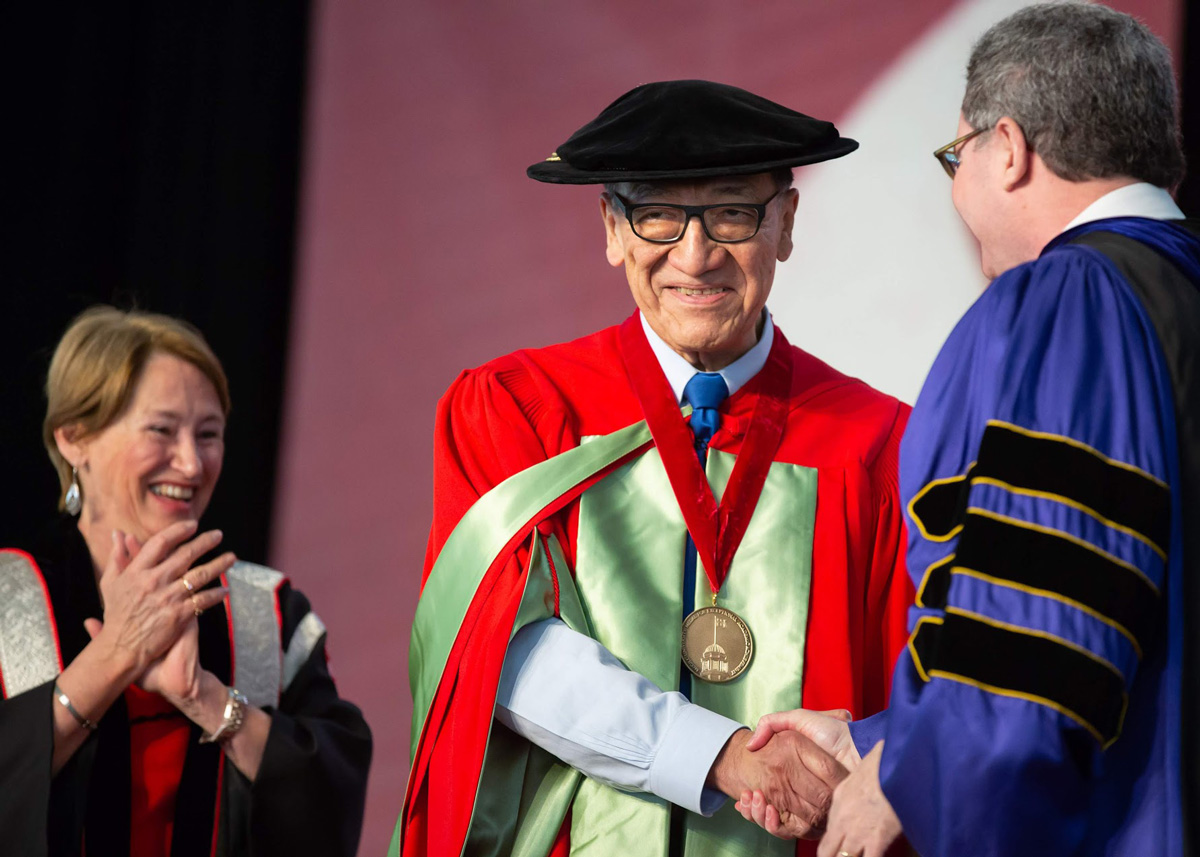
It started with a serious disagreement with a dean, 33 years ago, and it culminated in one of the University’s highest honours.
At the Faculty of Engineering’s Convocation ceremony, held Wednesday, May 30, Professor Jorge Angeles received the McGill Medal. Formally known as the Medal for Exceptional Academic Achievement, the award recognizes a retired professor who led a particularly distinguished career at McGill.
McGill was not even originally part of Prof. Angeles’ plan. After earning his PhD at Stanford in the early 1970s, he returned to his undergrad alma mater, the Universidad Nacional Autónoma de México. Eleven years later, he’d worked his way up to a full professorship in mechanical engineering.
“The plan was to stay there and not move,” he recalls. “But then I had a fight with the dean.” Angeles chuckles at the memory. “At that moment, I asked, ‘What the heck am I doing here?’ I started looking around.”
Another dean, Prof. Pierre Belanger of McGill’s Faculty of Engineering, invited Angeles to give a seminar here. Belanger, who would later serve as Vice-Principal (Research), was hatching a plan of his own: a new research centre devoted to robotics. As the former chair of the Department of Electrical Engineering, he knew plenty of electrical engineering talent—but he needed a mechanical engineer who’d fit into the mix.
“I got lucky,” says Angeles.
In 1984, Angeles and his wife traded Mexico City for Montreal. The following year, McGill’s Centre for Intelligent Machines (CIM) was born, with Angeles on board as a founding member.
Prof. Jim Nicell, who has been Dean of Engineering since 2013 and a member of the faculty for 26 years, laughs when he hears the story about Angeles’ fateful encounter with the dean in Mexico City.
“I’ve never had any trouble with him at all,” he says. “Jorge is absolutely solid in every respect. The McGill Medal recognizes well-roundedness. Yes, the scale of Jorge’s research output is phenomenal, but he has also been a stellar teacher, and a leader who’s been heavily involved in international collaborations, and collaborations across disciplines at McGill. It’s in putting together the full array of impacts that he’s had, that you see what an exceptional person Jorge is.”
Angeles is the tenth recipient of the McGill Medal in its nine-year history. The previous winners are professors Albert J. Aguayo, John Bergeron, Philip Branton, Adi Eisenberg, Margaret Lock, Roderick Macdonald, Brenda Milner, Lawrence Mysak and Donald Taylor.
Over the course of his McGill career, Angeles established himself as one of the world’s leading researchers in algorithm development for robot control and robot design. “In particular he is known for his fundamental contributions in the area of geometric analysis of kinematic chains, such as robot arms,” says Prof. Jim Clark, the CIM’s current director, “and the theory and design of motion generators and transmissions.”
“In some ways, Jorge was before his time,” adds Nicell. “With all the buzz there is around AI [artificial intelligence] right now, the fact is, the Centre for Intelligent Machines has been bubbling along at the center of that for decades. The computational power has only now caught up to where they are, and that is going to make their efforts leap into the stratosphere. They’re poised now to do even bigger and better things, and that’s a real credit to people like Jorge Angeles.”
When asked to reflect on his career, Angeles is quick to praise his graduate students—from his very first supervisee Clément Gosselin (who now holds the Canada Research Chair in Robotics and Mechatronics at Université Laval), to his current bench of seven PhD students, who are in varying degrees of completion.
Last November’s CIM Founders Symposium, held in honor of Angeles and Prof. Martin D. Levine, attracted several generations of McGill grads. “Many of Jorge’s students are now successful professors around the world, and they’d come back specifically to celebrate him,” recalls Nicell. “His impact goes way beyond this faculty and this university. The legacy he leaves behind will have its own life for decades to come.”
As much as he loved teaching, Angeles retired from the classroom last September so could spend more time with his family – including his four-month-old grandson – and to finish writing not one, but three text books developed from decades of his lecture notes.
There’s also the little matter of trying to build the world’s fastest pick-and-place robotic arm. The speed of these robots, commonly used to do repetitive tasks on assembly lines and in other industrial situations, is determined by how quickly they can cycle through a specific sequence of movements. In the early 2000s, Angeles witnessed another lab’s robot complete a record-breaking two cycles per second. Now there are labs claiming five cycles per second.
Angeles takes it as a challenge: “We’re still far from beating the fastest robot in the world, but we’re working on it.”
“The McGill Medal is a great honour,” he adds. “But I’m not done!”
